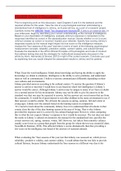Essay
Describe the 4 Natural causes of Long and Medium term Climate Change
- Module
- Unit 1 - Global Challenges
- Institution
- PEARSON (PEARSON)
A* essay answer for the exam question "Describe the 4 Natural causes of Long and Medium term Climate Change". This essay details the role of volcanic eruptions, cosmic collisions, variation in solar output and Milankovitch cycles in causing long and medium-term climate change. Written by an A* A...
[Show more]












